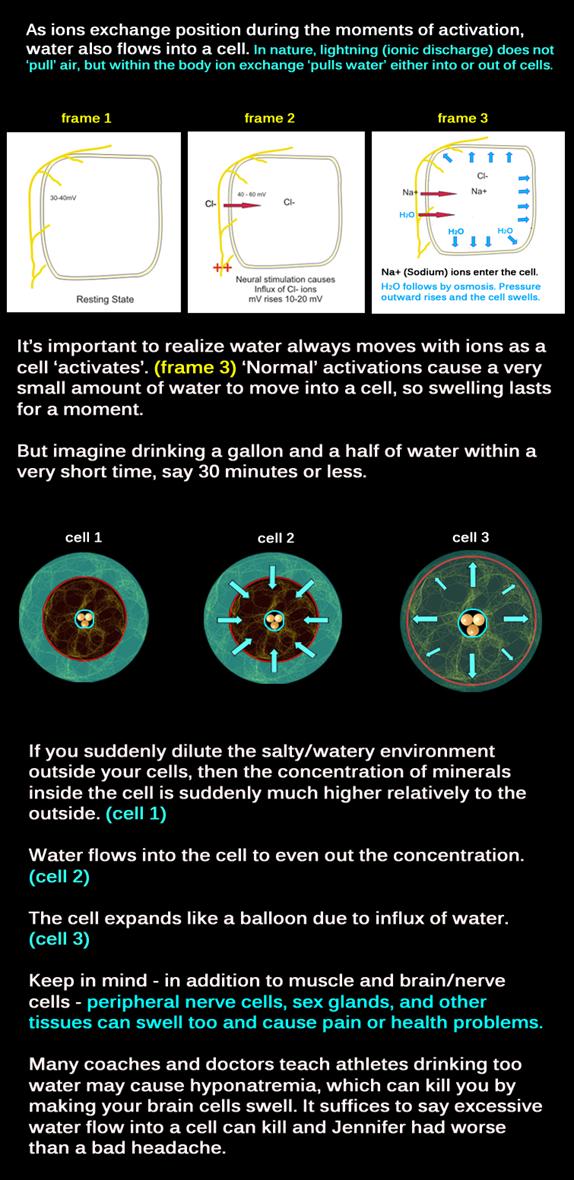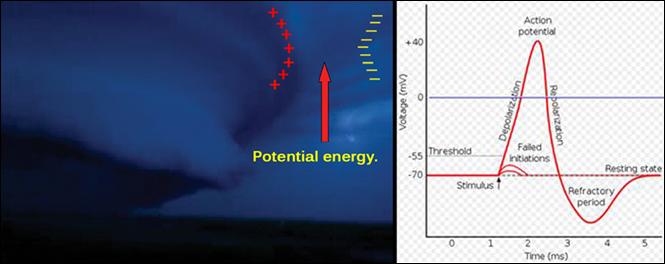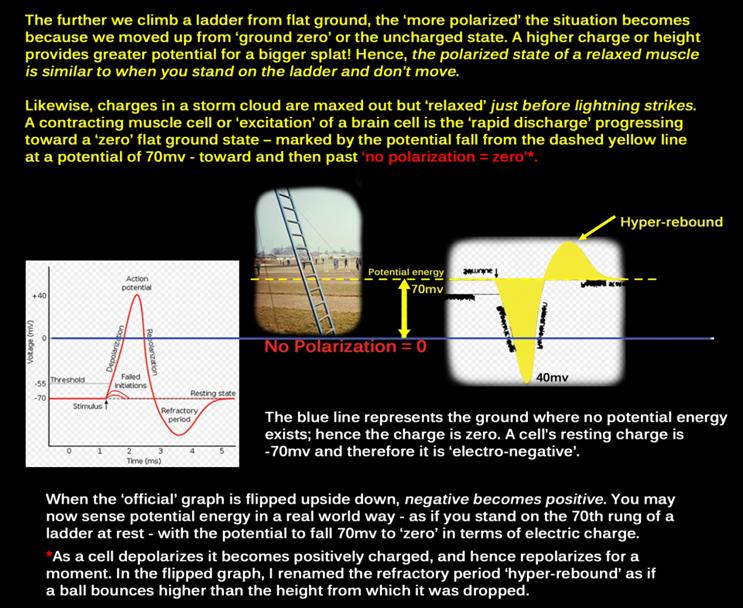Lesson 4: Muscles, Lightning, Brain Cells and Water
Part I: Usain Bolt, Electricity, Potassium, and High Intensity Muscle Contractions
Analogizing and comparing two different things often helps you understand the one thing you really need to understand. For example, this section compares different tissues of the body to one another, specifically brain to muscles. It may not seem like it now, but comparing the two provides powerful insight into principles of strength training, nutrition, and more.
A ‘tissue’ is simply a specific body part made up of particular cells. In other words, a group of cells ‘clumped’ together into an organized fashion make up a tissue. A specific tissue must function a certain way, like a fist-sized group of muscle cells contracting and pumping blood 24/7. Obviously, I just described heart tissue. Other tissues include brain, kidney, ovary, bone, prostate gland, etcetera, but keep in mind cells of specific tissue perform a specific purpose. For example, pancreas cells secrete insulin, ovary cells secrete estrogen and progesterone, and nerve cells send electrical signals.
Activating cells within a muscle or your brain resembles lightning ‘sparking’ within a thundercloud supercell. Below: two photos extracted from a video I took on my cell phone while steering clear of a tornado, headed eastward, south of I-80 in Nebraska, June, 2010.

The next several sections show how muscles and brain cells work ‘electrically’ through combining photos of a gigantic storm cloud with images of similar phenomena occurring in the human body.
The graph below shows potassium forced out of a muscle during repeated bouts of 1 minute of high intensity exercise. The moment lightning lights the sky (in frame 2 above) is analogous when the electrolyte potassium ‘shoots out’ of a muscle cell, graphed below.

This video demonstrates throwing common table salt (Na+ CL-) onto fresh frog legs ‘spark’ the electrical twitch of muscle cells. A muscle activates or ‘twitches’ as electrolytes pass through the exposed surface and into the muscle cells. We could also make a frog leg twitch by applying an electric current directly into the muscle with an electrode. Imagine the force produced by your muscle analogous to either a small or large stroke of lightning. The magnitude of the force produced by a muscle increases proportionally to the amount of ionic flow. If salt could be thrown on all the cells 3-dimensionally throughout the leg – and not just the surface of a few exterior cells – a more forceful twitch would occur. The ‘muscle twitch phenomenon’ or ‘action potential’ was once taught traditionally in high school biology classes by applying small or larger amounts of electricity to the frog leg to make it twitch either weakly or more forcefully. Sodium, potassium, calcium, and magnesium have the same effect as applying elctricity directly with an electrode. This explains why we call these minerals electrolytes.

Normally, the time frame of a lightning strike or potassium discharge during a single muscle twitch lasts only for milliseconds. This means both cloud cells and muscle cells quickly ‘relax’ and return to their resting state. At rest, each cell is potentially ready to ‘spark’ a new discharge. However, in the case of a constantly working muscle, potassium discharge continues unabated. This explains the rapid release of potassium, graphed below during 1-minute of high intensity exercise. In this case the cell does not relax; it stays ‘excited’ as potassium rapidly discharges out of muscles into the blood stream (labeled arterial plasma, middle frame below). Potassium levels return to ‘normal/resting’ levels after 4 minutes of rest. Extremely high potassium levels in the blood stream can stop your heart from beating. For example, Lee Harvey Oswald died not directly from his gunshot wound, but from excessive potassium released into his blood, which lead to cardiac arrest. Read this article, by Ray Peat to see his explanation.

You just learned an ‘imbalance’ of the electrolyte potassium can ‘arrest’ your heart beat. But the overall lesson is electrolytes constantly flow into and out of your cells in a never ending ‘balancing act’.
Contracting your muscles cause a momentary ‘imbalance’ of electrolytes as cells ‘activate’ but then should ‘rebalance’ on each side of the cell membrane as cells ‘relax’… all as quick as lighting. Magnesium relaxes the body by relaxing your muscles electrically. Calcium ions make your muscles ‘twitchy’ and when you die, calcium leakage permanently contracts your muscles as if posing like a body builder. We call this rigor mortis. People commonly take magnesium to regulate their heart beat in the sense the heart must ‘relax’ effectively in order to ‘beat’ effectively. The heart is electrical, muscle are too. Muscles produce ‘more power’ similarly to the heart when properly relaxed; the key to a ‘fast muscle’ is a relaxed muscle. See Olympic 100meter dash sprinters express exactly this in this video.
‘Normal’ physiology, health of blood and cells, and water balance are regulated by electrolytes. Magnesium is difficult to obtain comparatively to sodium, potassium and calcium. Potassium and magnesium deserve more attention, comparatively to calcium and sodium.
In a human cell, flow of electrolytes, water, and all nutrients is a two-way street, so imagine ‘ebb and flow’ like the ocean tide. Essentially, salty water stuff moves back and forth in cycles.
Next, we examine what happens when the balance of electrolytes becomes ‘unbalanced’ within the watery medium surrounding cells.
HEADLINE: Jennifer Strange, 28, died Jan. 12, 2007 of water intoxication, or hyponatremia, after drinking more than 1.5 gallons of water while taking part in a “Hold Your Wee for a Wii” contest.
An overflow of water into her brain cells killed her. The next few sections illustrate the ‘ebb and flow’ of water and electrolytes into and out of cells of the human body.
http://www.onpointnews.com/NEWS/Radio-Stunt-Contestant-Had-Role-in-Own-Death.html

First, we compare the similarity of a thundercloud and the transfer of ions within a supercell and a human cell. Ions have plus or minus charges whether dissolved in water/blood or suspended in air. In frame 1, ions in a thundercloud supercell build up, establishing a ‘static electrical potential’. Then a ‘discharge’ of ionic flow lights the sky and ‘activates’ the cloud cell, frame 2. The cell ‘relaxes’ into darkness, frame 3.
The lightning ‘flash’ is analogous to the moment K+ (potassium) is rapidly discharged out of a cell during 1 minute of intense exercise.

In a human cell, electrolyte exchange is only ‘half the story’ of activating a cell; water is ‘pulled’ simultaneously into a cell as it activates. Remember, movement of ions or salt into a muscle cell makes it twitch or contract, as seen in the frog video. But what you did not see is water moving into the cell as ions move.
Normally, water immediately moves back outside the cell as it relaxes. In other words, the balance of electrolytes on each side of the cell returns to their ‘normal’ resting concentrations. More specifically, after stopping exercise, water moves outward from muscle cells to ‘calm’ and relax the muscle; electrolytes also flow back in/out to their ‘normal’ respective positions/concentrations. However, ‘overly sustained’ exercise or chronic overuse ‘pulls’ water into cells – and tends to keep water from leaving cells even after stopping exercise. This explains why chronically fatigued nerves and muscles ‘hold water’.
An extreme form of ‘cells holding water’ explains what killed Jennifer Strange as illustrated below.

Notice in frame 2 above, chloride (not calcium) triggered the cell; in this case the cell of a gland, not a muscle cell. This serves to show particular cells use different ionic ‘triggers’. Calcium ions trigger muscle contractions, which explains why rigor mortis occurs after death. Water and ionic flow occurs in all cells, not just muscle, brain, or peripheral nerve cells. For the record, the creator of this sketch annotated it, Illustrating mechanism for transportation of water and electrolytes across epithelial cells in secretory glands. See the original sketch; click here.
Part II: Relaxation vs. Excitation (or ‘Action Potential’)
Human cells ‘relax’ or become electrically ‘excited’ due to the ebb and flow of water and minerals.
A relaxed muscle is one that has potential, but is doing nothing, similar to the frame 1 storm cloud, when conditions for a lightning strike is ripe. In other words, a resting thundercloud or a resting cell is polarized, meaning it has a strong ‘electrical action potential’ like a super strong battery, the type you prefer to have in your car when it’s 20 below freaking zero in January. Polarized electrical charges simply indicate a division of plus/minus charges exists, but other things may be polarized too, such as political views or the air of Earth. For example, the cold north and south poles of the earth are ‘polarized’ in terms of temperature, comparatively to the hot equatorial region.

The ‘official’ way to graph a muscle’s electric potential, shown next to the thundercloud isn’t compatible with the way physics is classically taught or with the humans perceive ‘positive and negative’ with respect to flat ground, (i.e. high above ground = positive and below ground = negative). The next section corrects this problem.
First, the ‘official’ way to graph action potential above misleads people to think “potential = action” by labeling the peak of the red line ‘action potential’. The cell has ‘potential to take action’ where the red line is flat, at -70mV. This is when a cell is in the rested ‘polarized state’ – relaxed. At -70 mV you are doing nothing, akin to a battery not cranking the starter when your car engine is off or to a ball resting on the edge of a hill ‘waiting’ to get pushed and roll down the hill. In classical physics, potential never represents action. For example, height of a hill represents potential energy not the action.
The height at which you stand on the top rung of a ladder represents the quantity of potential energy, not action. Hence, the polarized state of a relaxed muscle is similar to standing high up on a ladder. This explains why I flipped the graph upside down, placed the bottom of the ladder at the ‘zero: no polarization’ ground state. Now -70mV is ‘above ground’ and corresponds to our way of perceiving potential energy in the real world. The zero state equates to a balance of positive and negative charges on each side of a cell membrane. In a zero charge state we would be dead, muscles would not contract, and brain cells would not light up an MRI scan. Now you understand the condition from which Mary Shelley imagined the creation of Frankenstein. The original title was Frankenstein or The Modern Prometheus. Prometheus.

We sense things fall downhill, not up. But since electrical charges are arbitrary, scientists classically plot negative charges below zero. Hence, the maximum potential energy is at the bottom of the graph at -70mv. But in the ‘fixed’ yellow to the right of Earth -70 is now ‘up from zero or ‘flat ground’. Further, as a cell ‘depolarizes’ it becomes positively charged for a moment and hence repolarizes in the opposite direction. This should be termed ‘moment of action’ as opposed to action potential. Then there’s a refractory period. I renamed this ‘hyper-rebound’ in the fixed yellow graph. Discharge, refractory periods, rebounds, hmm… double entendres!
Part III: Pain, Stress, Inflammation, and Swelling
Build the Integrative Power of Your Brain and Keep Pushing the Limits.
An excited or relaxed cell is synonymous with the flow of water and electrolytes. In short, mineral or ion flow across a cell membrane = ‘electrolyte activity’ like a lightning bolt. Muscle, nerve, or uterus cells all react similarly to their degree of hydration, and mineral ‘charge’. (Nerve cells may be peripheral, spinal, or brain cells) It’s easy to know and feel when a muscle cell is ‘stimulated’ or ‘excited’ muscle cell because we feel tension and/or move. It’s easy to feel and imagine a muscle cell at rest too. But it is NOT easy to know or feel nerve cells ‘excite’ or ‘activate’ like a muscle until we feel pain. The connections among cell ‘excitation/relaxation’ and ‘water/mineral’ balance and pain and pathology are rarely made or understood. But all cells react essentially the same way muscle cells do when excited or at rest. See an animation of an ‘action potential’ in a human cell, click here.
Chronic fatigue and stress is synonymous with ‘overexcitation’ of your body (cells). Imbalanced electrical forces, i.e. imbalanced electrolyte flow keep cells activated and prevent them from relaxing. Water moves concomitantly with electrolytes and is ‘held’ in place by electrical force. Water held in a cell is a reflection of overstimulated swollen cells. Chronic excitation is synonymous with a fatigued cell – nerve or muscle. ‘Globally’ speaking – in terms of your whole body – chronically excited cells are simply fatigued cells, whether they are nerve, muscle, brain, or prostate gland cells. Overhydration = excessive water maintained or ‘held’ inside a cell.
Inflammation is: “swelling of a cell or entire ‘compartment’ of tissue.” For example, an enlarged heart is a swollen heart; all the muscle cells have ‘swelled’ similarly to the inflammation you see on your skin from a mosquito bite. It is no coincidence that an enlarged heart is a failing heart – a fatigued and swollen heart – deprived of energy or incapable of using energy because it has been overstimulated and ‘tired’. At the micro level, overexcited nerve cells in the wrist may swell, which causes pain associated with carpal tunnel syndrome. An underactive thyroid or hypothyroidism can cause nerves to swell. Obviously, realizing how such connections exist requires further study.
Generally, we do not sense low levels of inflammation or ‘excitation’. The degree to which inflammation may be damaging or healing the body, depends on whether it is an acute short term response or chronic condition. We readily notice high level, acute responses of swelling such as a mosquito bite or severe ankle sprain. Water just gets ‘shoved around’ from one space to another and expands the cells – or may leak out of the blood stream into the space around cells. You can learn to feel low levels of inflammation, which is wise if you are an athlete who wants to avoid injury and overtraining. Discover how by asking questions.
Electrophysiology is the key for understanding strength training, pain, inflammation, and the immune system. Once you visualize the division among spaces and parts within your body – health and function all comes down to nutrients, ions, and water moving from one compartment to another. Water and ions remain suspended in position or ‘held in check’ by electrical repulsion like 2 magnets repelling one another. Water and ions constantly flow across space from one compartment to another when a disturbance occurs. You are alive, so disturbance is the norm.
You disturb the resting ‘ionic state’ of a muscle when you move. Unlike any other cell, you control muscle cells, so you control the electrical force and the power or strength applied. Essentially, examining flow of water and the ions, sodium, potassium, calcium, magnesium, and chloride into and out of a body part is a gateway for concretely understanding fatigue, injuries, diseases, and many problems with the body. And where there’s a gateway, you often find a simple solution to the problem. To learn more, read Ray Peat’s article Water: swelling, tension, pain, fatigue, aging. http://raypeat.com/articles/articles/water.shtml
Mineral balance goes hand in hand with water balance. Hydration is controlled by minerals. Water flow ‘obeys’ electrolyte balance. Electrolyte drinks are ‘supposed to’ maintain mineral/water balance but usually provide too much sodium and not enough potassium.
This section was just an introduction to the purpose and wisdom of comparison, metaphor, and analogy. It is not only helpful to compare different types of cells to one another such as brain cells to muscle cells – it is also useful to analogize a lightning bolt to the ‘spark’ of a cell as it relaxes or ‘gets excited’. Linus Pauling called minerals the ‘spark of life’ for a very good reason, because it is so. Static electric force is a ‘physical force’ we humans can learn to manipulate for improving the health of our blood and cells.
Analogizing or comparing two different things often helps to better understand the one thing you really need to understand. Making connections is the key to building an integrated view of the whole.
